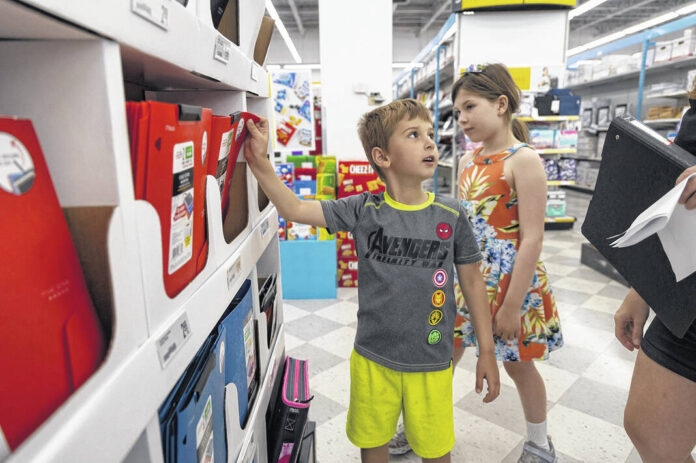Nicole Sebastian has been “a little choosier” when buying school supplies for her two kids this year. With inflation at its highest since the early 1980s, prices are up across the board, and notebooks and markers are no exception.
Sebastian bought most of her kids’ supplies — including coloring and craft supplies for her first grader, Bruno, and graph paper and a protractor for her fourth grader, Ophelia — at Target. When she couldn’t find a flexible binder Bruno needed, she ventured to OfficeMax. Thinking Post-it Notes would be cheaper there, she put the ones from Target back on the shelf.
Sebastian estimates she’s spent about $200 on school supplies for her kids. And she hasn’t yet bought new backpacks or uniforms, which are required in her children’s Chicago Public Schools classrooms. School starts Aug. 22 this year, the earliest first day in years.
“It is kind of adding up now,” she said.
The Consumer Price Index hit 9.1% in June as Chicagoans continued to manage sky-high prices of everything from food to gas. Now, back-to-school costs are adding up, too.
“Our school is like 30% low-income, so I would think this would be a significant cost for those students,” Sebastian said.
Sebastian sometimes purchases more items than her own kids need, sending them to school with an eight-pack of glue sticks instead of four, for example, so they can share with their classmates.
But back-to-school costs are still a burden for many families, said employees at nonprofits that serve kids.
“We get so many calls … from parents or families that are saying, ‘You know what, my husband lost his job, we’re barely making our rent, we’ve got to get school supplies for our kids as they go back to school, how can you help us?’ ” said Steven Sartin, associate director of Back 2 School America, a nonprofit that provides school supplies to kids.
“That has increased dramatically,” he said.
By the end of August, Sartin said, Back 2 School America plans to distribute over 30,000 back-to-school kits full of supplies to children who need them. Most of the school supplies will go to kids in Illinois, he said; the organization, which used to be known as Back 2 School Illinois, recently expanded beyond the state.
Back 2 School America works with a variety of community partners, such as the YMCA and the Boys & Girls Clubs of America, to get school supplies to the kids with the greatest need.
The nonprofit is feeling the effects of inflation, too, Sartin said, even though it can get better deals on school supplies than the average person because it buys in bulk. But Sartin said large corporations that sponsor school supplies with the nonprofit have taken note of the greater need and have stepped up to help.
According to a national Deloitte survey of 1,200 parents of school-age kids, families plan to spend 8% more on school supplies than they did last year.
At the same time, a third of parents nationally said their family’s household situation had worsened since last year. This year, almost 60% of parents surveyed said they were worried about increasing costs of back-to-school items due to inflation.
On the whole, back-to-school spending is expected to reach a new high of $34.4 billion for kids in elementary through high school, up from a forecast of $32.5 billion last year, according to the Deloitte research.
While many parents said they were worried about items being out of stock, executives at companies from Kohl’s to Shoe Carnival to Tillys have assured investors that inventory issues and shortages won’t be a problem this year.
Michelle Gass, CEO of Kohl’s, said at a recent conference that the company would be well-positioned compared with last year, when kids’ products were hard hit by supply chain disruptions.
“We were in chase mode in an environment where it was very difficult to chase,” Gass said, noting the company had planned last year’s season conservatively and found itself with a deficit of product in certain areas, including kids’. “So, we have course corrected that.”
Adams said he didn’t expect supply chain issues to be as large of a problem as last year.
“Some of the issues that we saw in terms of production and shipping have been resolved, but also, retailers have invested in their supply chains to get out in front of concerns, I think, a little bit more proactively,” he said.
Even before the pandemic, the cost of school supplies was a burden to low-income families, said Jan Waters, chief program officer of clinical services for the Chicago Children’s Advocacy Center, which provides services to kids who have experienced abuse. The center runs a yearly backpack drive for the kids it serves. This year, costs are an even greater burden, Waters said.
Some schools have added additional health and safety gear to their supply lists, she said.
“They have all the stuff that we’ve always traditionally needed, but now they also have added in hand sanitizer, and tissue and wipes,” she said.







